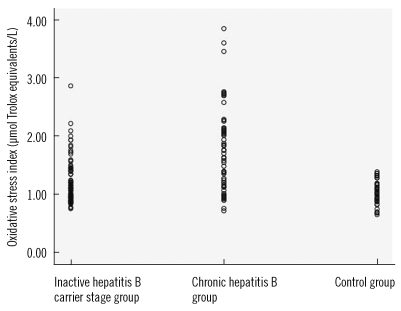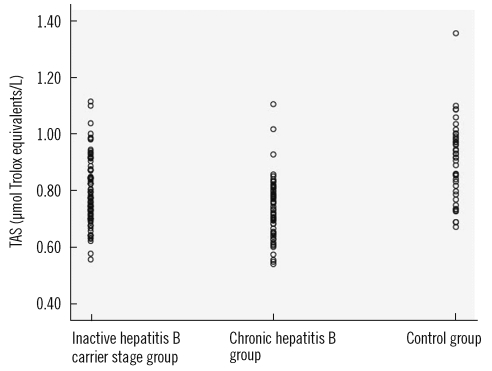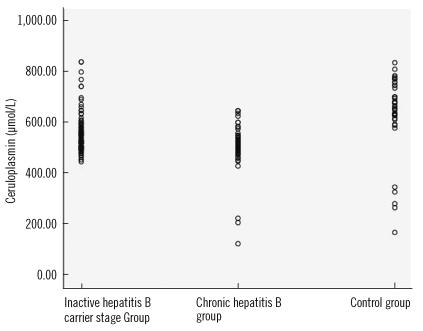Ann Lab Med.
2012 Mar;32(2):113-118. 10.3343/alm.2012.32.2.113.
Relationship of Oxidative Stress in Hepatitis B Infection Activity with HBV DNA and Fibrosis
- Affiliations
-
- 1Department of Infectious Disease and Clinic Microbiology, Tokat State Hospital, Tokat, Turkey. drfduygu@gmail.com
- 2Department of Infectious Disease and Clinic Microbiology, Faculty of Medicine, Harran University, Sanliurfa, Turkey.
- 3Department of Biochemistry, Faculty of Medicine, Harran University, Sanliurfa, Turkey.
- KMID: 1245250
- DOI: http://doi.org/10.3343/alm.2012.32.2.113
Abstract
- BACKGROUND
The aim of this study was to evaluate oxidative stress in various clinical forms of hepatitis B infection and to investigate its role in the development of the chronic form of the disease.
METHODS
Ninety-three patients with inactive hepatitis B surface antigen (HbsAg) carrier state (IHBCS), 65 patients with chronic hepatitis B infection (CHB), and 42 healthy adults were included in the study. The following values were measured and compared in patient groups: total antioxidant status (TAS), total oxidative stress (TOS), oxidative stress index (OSI), sulfhydryl (SH), lipid peroxidation (LOOH), catalase (CAT), and ceruloplasmin. In patients with chronic hepatitis B, these values were compared with HBV DNA and fibrosis levels.
RESULTS
ALT, TOS, LOOH, and OSI levels were higher in the CHB group compared to the other groups (P<0.001). Catalase levels increased in the CHB and IHBCS groups compared to the control group (P<0.001). Total aminooxidant and ceruloplasmin levels were found to be lowest in the CHB group and highest in the control group (P<0.001). Sulfhyrdyl was higher in the control group compared to the other groups (P<0.001). In the CHB group, there was no correlation between the HBV DNA and OSI (P>0.05).
CONCLUSIONS
These finding suggested that oxidative stress is associated with hepatitis B activity.
Keyword
MeSH Terms
-
Adolescent
Adult
Aged
Alanine Transaminase/blood
Antioxidants/metabolism
Carrier State
Catalase/blood
DNA, Viral/*analysis
Female
Fibrosis
Hepatitis B/*metabolism/pathology
Hepatitis B Surface Antigens/blood
Hepatitis B virus/*genetics
Hepatitis B, Chronic/metabolism/pathology
Humans
Lipid Peroxidation
Male
Middle Aged
*Oxidative Stress
Sulfhydryl Compounds/blood
Young Adult
Figure
Reference
-
1. Koziel MJ, Siddiqui A. Mandell GL, Douglas RG, editors. Hepatitis B virus and hepatitis Delta virus. Principles and practice of infectious diseases. 2005. 6th ed. Philadelphia: Churchill Livingstone;p. 1864–1890.
Article2. Koff RS. Schiff L, Schiff ER, editors. Viral hepatitis. Diseases of the liver. 1993. 7th ed. Philadelphia: JB Lippincott Company;p. 492–577.3. Moriya K, Nakagawa K, Santa T, Shintani Y, Fujie H, Miyoshi H, et al. Oxidative stress in the absence of inflammation in a mouse model for hepatitis C virus-associated hepatocarcinogenesis. Cancer Res. 2001; 61:4365–4370. PMID: 11389061.4. Dikici I, Mehmetoğlu I, Dikici N, Bitirgen M, Kurban S. Investigation of oxidative stress and some antioxidants in patients with acute and chronic viral hepatitis B and the effect of interferon-α treatment. Clin Biochem. 2005; 38:1141–1144. PMID: 16300751.
Article5. Lok L Anna S.F., McMahon Brian J.AASLD Practice Guidelines Chronic Hepatitis B: Update 2009.6. Knodell RG, Ishak KG, Black WC, Chen TS, Craig R, Kaplowitz N, et al. Formulation and application of numerical scoring system for assessing histological activity in asymptomatic chronic active hepatitis. Hepatology. 1981; 1:431–435. PMID: 7308988.7. Erel O. A novel automated method to measure total antioxidant response against potent free radical reactions. Clin Biochem. 2004; 37:112–229. PMID: 14725941.
Article8. Góth L. A simple method for determination of serum catalase activity and revision of reference range. Clin Chim Acta. 1991; 196:143–151. PMID: 2029780.
Article9. Ellman GL. Tissue sulfhydryl groups. Arch Biochem Biophys. 1959; 82:70–77. PMID: 13650640.
Article10. Hu ML, Louie S, Cross CE, Motchnik P, Halliwell B. Antioxidant protection against hyochlorous acid in human plasma. J Lab Clin Med. 1993; 121:257–262. PMID: 8381845.11. Conti M, Morand PC, Levillain P, Lemonnier A. Improved fluorometric determination of malondialdehyde. Clin Chem. 1991; 37:1273–1275. PMID: 1855301.12. Sunderman FW Jr, Nomoto S. Measurement of human serum ceruloplasmin by its p-phenylenediamine oxidase activity. Clin Chem. 1970; 16:903–910. PMID: 5473551.
Article13. Pawlotsky JM. The concept of hepatitis B virus mutant escape. J Clin Virol. 2005; 34(Suppl 1):S125–S129. PMID: 16461211.
Article14. Curry MP, Chopra S. Mandell GL, Bennett JE, editors. Acute viral hepatitis. Principles and practice of infectious diseases. 2005. 6th ed. Philadelphia: Churchill Livingstone;p. 1426–1441.
Article15. Abdollahi M, Bahreini-Moghadam A, Emami B, Fooladian F, Zafariet K. Increasing intracellular cAMP and cGMP inhibits cadmium-induced oxidative stress in rat submandibular saliva. Comp Biochem Physiol C Toxicol Pharmacol. 2003; 135C:331–336. PMID: 12927907.
Article16. Abdollahi M, Ranjbar A, Shadnia S, Nikfar S, Rezaie A. Pesticides and oxidative stress: a review. Med Sci Monit. 2004; 10:RA141–RA147. PMID: 15173684.17. Yeum KJ, Russell RM, Krinsky NI, Adlini G. Biomarkers of antioxidant capacity in the hydrophilic and lipophilic compartments of human plasma. Arch Biochem Biophys. 2004; 430:97–103. PMID: 15325916.
Article18. Yagi K. Armstrong D, editor. Lipid peroxidase and related radicals in clinical medicine. Free radicals in diagnostic medicine. 1994. New York: Plenum Press;p. 17–27.19. Erel O. A new automoted colorimetric method for measuring total oxidant status. Clin Biochem. 2005; 38:1103–1111. PMID: 16214125.21. Jain SK, Pemberton PW, Smith A, McMahon RF, Burrows PC, Aboutwerat A, et al. Oxidative stress in chronic hepatitis C: not just a feature of late stage disease. J Hepatol. 2002; 36:805–811. PMID: 12044532.
Article22. Aksoy N, Vural H, Sabuncu T, Aksoy S. Effects of melatonin on oxidative-antioxidative status of tissues in streptozotocin-induced diabetic rats. Cell biochem Funct. 2003; 21:121–125. PMID: 12736900.
Article23. Cross CE, Halliwell B, Borish ET, Pryor WA, Ames BN, Saul RL, et al. Oxygene radicals and human disease. Ann Intern Med. 1987; 107:526–545. PMID: 3307585.24. Vural H, Sabuncu T, Arslan SO, Aksoy N. Melatonin inhibits lipid peroxidation and stimulates the antioxidant status of diabetic rats. J Pineal Res. 2001; 31:193–198. PMID: 11589752.
Article25. Swierczynski J, Kochan Z, Mayer D. Dietary α-tocopherol prevents dehydropiandrosterone-induced lipid peroxidation in rat liver microsomes and mitochondria. Toxicol Lett. 1997; 91:129–136. PMID: 9175849.26. Gantt KR, Goldman TL, McCormick ML, Miller MA, Jeronimo SM, Nascimento ET, et al. Oxidative responses of human and murine macrophages during phagocytosis of Leishmania chagasi. J Immunol. 2001; 167:893–901. PMID: 11441096.27. Murray HW, Teitelbaum RF. L-arginine-dependent reactive nitrogen intermediates and the antimicrobial effect of activated human mononuclear phagocytes. J Infect Dis. 1992; 165:513–517. PMID: 1538156.
Article28. Cemek M, Dede S, Bayiroglu F, Caksen H, Cemek F, Mert N. Oxidant and non-enzymatic antioxidant status in measles. J Trop Pediatr. 2007; 53:83–86. PMID: 17158812.
Article29. Draganov D, Teiber J, Watson C, Bisqaier C, Nemzek J, Remick D, et al. PON1 and oxidative stress in human sepsis and an animal model of sepsis. Adv Exp Med Biol. 2010; 660:89–97. PMID: 20221873.
Article30. Bayraktar N, Kilic S, Bayraktar MR, Aksoy N. Lipid peroxidation and antioxidant enzyme activities in cancerous bladder tissue and their relation with bacterial infection: a controlled clinical study. J Clin Lab Anal. 2010; 24:25–30. PMID: 20087949.
Article31. Lin CC, Liu WH, Wang ZH, Yin MC. Vitamins B status and antioxidative defense in patients with chronic hepatitis B or hepatitis C virus infection. Eur J Nutr. 2011; 50:499–506. PMID: 21184088.
Article32. Kageyama F, Kobayashi Y, Kawasaki T, Toyokuni S, Uchida K, Nakamura H. Successful interferon therapy reverses enhanced hepatic iron accumulation and lipid peroxidation in chronic hepatitis C. Am J Gastroenterol. 2000; 95:1041–1050. PMID: 10763957.
Article33. Mahmood S, Kawanaka M, Kamei A, Izumi A, Nakata K, Niiyama G, et al. Immunohistochemical evaluation of oxidative stress markers in chronic hepatitis C. Antioxid Redox Signal. 2004; 6:19–24. PMID: 14713333.
Article34. Demirdag K, Yilmaz S, Ozdarendeli A, Ozden M, Kalkan A, Kilic SS. Levels of plasma malondialdehyde and erythrocyte antioxidant enzyme activities in patients with chronic hepatitis B. Hepatogastroenterology. 2003; 50:766–770. PMID: 12828081.
- Full Text Links
- Actions
-
Cited
- CITED
-
- Close
- Share
- Similar articles
-
- HBV DNA Levels, Aminotransferase and Histological Activity in Young Male Patients with HBeAg Positive Chronic Hepatitis B
- Occult Hepatitis B Virus Infection in Patients with Chronic Hepatitis C: Innocent Bystander or Not?
- Relationship between Serum HBV DNA Levels and Liver Histology in Chronic Hepatitis B
- Chronic Hepatitis B in Pregnancy
- Occult Hepatitis B Virus Infection in Chronic Hepatitis C




